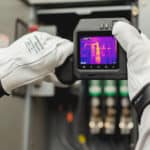An arc flash study is required to ensure the safety of your employees who work with or near electrical equipment. A report published in Industrial Safety and Hygiene News estimated that, on average, there are 30,000 arc flash incidents yearly, underscoring the importance of putting in the right processes.
But what exactly is arc flash? Caused by a sudden release of energy caused by an electrical fault or short circuit, they are defined as an explosion that can cause severe injury or even death to nearby people.
An arc flash study evaluates the potential for an arc flash event and calculates the energy that would be released. It considers factors such as the available fault current, the equipment’s rating and design, the configuration of the electrical system, and the type of protective devices in place.
The results help you identify hazards and determine appropriate safety measures to protect your team. These measures include modifying equipment design, providing personal protective equipment (PPE), implementing administrative controls, or developing safe work practices.
What Causes an Arc Flash?
An arc flash is an electrical explosion when an electric current flows through the air between two conductors or from a conductor to the ground. These incidents are typically caused by interaction with an energized circuit, environmental conditions, or equipment failure.
When an arc flash occurs, the electric current heats the air between the conductors to extremely elevated temperatures, producing a bright flash of light, intense heat, and a powerful blast of pressure. The arc flash can cause severe damage to electrical equipment and pose a significant safety hazard to any employee nearby.
4 Common Causes of Arc Flash Incidents
1. Faulty equipment
An arc flash can occur when your electrical equipment is not correctly maintained, is outdated, or needs repairs.
2. Human error
An improper electrical work practice commonly seen would be using tools not rated for the correct voltage. Additionally, employees accidentally touching a live wire or not following proper lockout/tagout procedures when working on electrical equipment can lead to an arc flash.
3. Environmental factors
Environmental factors, such as moisture, dust, or other contaminants, can create a conductive path between conductors and lead to an arc flash.
4. Design and installation issues
It is essential to have proper design and installation of electrical equipment or systems in your facility that can contribute to an arc flash incident. For example, equipment that needs to be correctly grounded or protected against over-currents can increase the likelihood of an arc flash.
Following proper electrical safety practices and procedures ensures that all electrical equipment is properly maintained and in good working condition to prevent an arc flash incident.
Why is an Arc Flash Study Required?
Arc flash studies are required to assess your electrical system’s potential risk of arc flash hazards. The main goal is to identify the dangers associated with an electrical system and develop appropriate safety measures to protect workers from potential risks.
The benefits of an arc flash study include the following:
1. Worker safety
The primary reason for conducting an arc flash study is to protect your people from the potential hazards associated with an electrical system that can lead to injury or death.
2. Compliance with regulations and standards
NFPA 70E electrical safety regulations and standards are set by organizations like the National Electrical Code (NEC) and National Fire Protection Association. A proactive arc flash study can help you comply with these regulations and standards set by OSHA and other governing entities by identifying the hazards associated with the electrical system and implementing appropriate safety measures.
3. Risk management
You can reduce the risk of injury, property damage, and other adverse outcomes by identifying potential hazards and implementing appropriate safety measures.
4. Equipment reliability
You can modify the electrical system to reduce the risk of equipment failure and improve uptime and the reliability of the electrical equipment.
When is an Arc Flash Study Required?
An arc flash study is required when you install, upgrade, or modify electrical equipment, as it may change the electrical system and affect the incident energy or arc flash hazard levels.
Arc flash studies are recommended in many different situations, including:
1. New facility construction
When constructing a new facility, an arc flash study is required to assess the arc flash hazards associated with the electrical equipment installed.
2. Equipment replacement or retrofit
Reassess the arc flash hazards associated with replaced or retrofitted equipment.
3. System changes or modifications
When changes to the electrical system could affect the incident energy or arc flash hazard levels, such as adding new equipment, modifying the electrical distribution system, or changing protective device settings.
4. Safety program compliance
Highly safety-conscious organizations require periodic arc flash studies for their electrical safety program compliance.
Arc Flash Requirements for New Builds, Equipment Replacements, and Retrofits
The National Electrical Code (NEC) sets guidelines and standards for arc flash safety in new electrical installations, equipment replacements, and retrofits. The NEC Article 240.87 outlines requirements for arc flash safety.
In addition, the NEC requires labels with information about the potential arc flash hazards and the appropriate personal protective equipment (PPE) on the new electrical installations. Labeling helps workers understand the electrical system’s associated risks and take proper precautions to protect themselves.
It is important to note that arc flash safety is a complex issue. Depending on your facility’s location, additional requirements and guidelines may exist at the local, state, or national level.
Arc flash safety requirements include:
1. Conducting an arc flash hazard analysis
This analysis must consider your system voltage, available fault current, and other factors that could contribute to an arc flash event from the energizing of an electrical system.
2. Selecting appropriate protective devices
Protective devices, such as circuit breakers and fuses, must be selected and installed according to your arc flash hazard analysis results. These devices interrupt the fault current within a specified time to minimize the energy released during an arc flash event.
3. Providing appropriate personal protective equipment (PPE)
Workers exposed to arc flash hazards must receive proper PPE, such as arc-rated clothing, gloves, and face shields. The specific level of PPE required will depend on the arc flash hazard analysis results.
4. Labeling electrical equipment
Appropriate warning labels are used on electrical equipment that poses a potential arc flash hazard. These labels inform your employees about the potential danger, appropriate PPE required, and other relevant safety information.
5. Implementing an electrical safety program
Establish an electrical safety program to address the hazards associated with electrical equipment replacement or retrofit. Your program should include procedures for de-energizing the electrical system, verifying that the system is de-energized, and safely working on energized electrical equipment, if necessary.
6. Provide training and education
Workers involved in the replacement or retrofit of electrical equipment should be trained in hazards associated with arc flashes and the proper use of PPE.
Maximize the Benefits of Your Arc Flash Study
Understanding the common arc flash incidents and why/when it is required will help you get the most out of an arc flash study. Specific requirements for each new build, equipment replacement, and retrofit will depend on the size and complexity of the electrical system, as well as other factors such as the location and intended use of the system.





